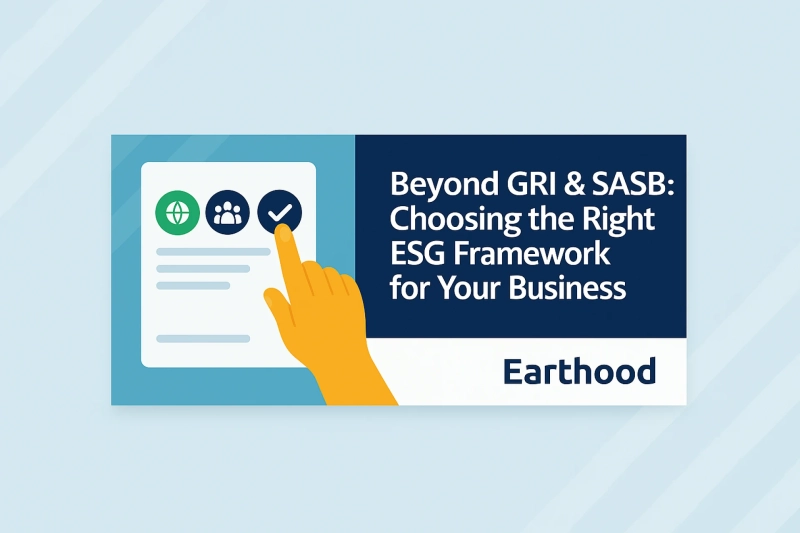Have you been pondering questions like, “Is GRI relevant in 2025 with new ISSB standards expected to take over?” or “What if I go with the GRI framework and it turns out to be the wrong fit for my business?” Keep no worries if you are buried under a pile of ESG acronyms and wondering what framework to use.
The ESG landscape has undergone significant changes in the last few years. Using the wrong framework could either put you on the path to streamlined compliance success or lead to costly missteps. Let's look at some options in plain English.
Understanding the ESG Framework Terrain
Consider ESG frameworks as different languages telling the same sustainability narrative. Just like you wouldn’t use Spanish to a person who only speaks French, you wouldn’t use any framework to tell your story without regard for your audience. Standards focus on governance, while frameworks concentrate on the overarching approach.
For instance:
GRI and TCFD are frameworks because they outline the overarching structure and core themes (such as climate-related risks or social impact). Then some standards provide more granular, operational guidance on reporting. Most importantly, understand what each framework is meant to achieve and who within your business requires it.
GRI: The Comprehensive Approach
The most multifaceted and versatile approach to ESG reporting is the GRI (Global Reporting Initiative). It is the most holistic and principle-centered approach to sustainability.
If you need to convey your company’s impact story, GRI is most suited to telling a comprehensive narrative. It addresses environmental, social, and governance issues, as well as their interconnections.
The GRI framework is ideal for companies that prefer a broad approach to sustainability reporting since it captures multiple stakeholders, diverse ESG topics, and issues.
Regardless, GRI can be overwhelming for smaller companies or those just beginning their ESG journey using this framework.
SASB: Industry-Specific Focus
SASB (Sustainability Accounting Standards Board) stands out with its focus on industry-specific materiality – that is, vital sustainability matters pertinent to your line of business.
For example, SASB will concentrate on different Oil and Gas issues than those for Healthcare or Technology. This is one of the reasons why SASB is particularly useful for investors trying to understand the scope of financial risks.
SASB allows the determination of profits by assessing sustainability challenges through financial materiality by industry.
TCFD: Reporting on Climate Issues
Climate reporting can be best sourced from the TCFD (Task Force on Climate-related Financial Disclosures). It centers around climate risks and opportunities as well.
If you have significant climate risks pertinent to your business operations, or if you are keen on defending your climate position towards your investors, the TCFD is a must. This is equally helpful to businesses operating in climate-sensitive sectors such as agriculture, energy, and manufacturing.
Climate-related financial risks are a key focus of the TCFD, as one of the most pressing issues currently concerning financial markets.
New Entrants: ISSB and CSRD
The ESG reporting landscape is being shaped ahead of an anticipated 2025 deadline for new disclosures. As regions around the world prepare for 2025, the landscape for global ESG reporting continues to take good shape.
The ISSB has introduced new global standards as part of a greater set of international frameworks created by the ISSB for the IFRS. These frameworks require businesses to disclose information on sustainability risks and opportunities that impact their operations and financial results.
S1 outlines general sustainability disclosures, while S2 focuses on climate-related risks and opportunities. Both are compliant with the TCFD and its objectives of integrating international ESG disclosure.
An additional shift in legislation within the region is the CSRD. Affected businesses that fall under the NFRD will transition to the CSRD reporting framework in 2025.
Adoption Trends Globally in 2025
As of March 13, 2024, five jurisdictions have adopted the standards and eleven more plan to do so shortly. Australia and Canada have adopted the standards, but are at different stages of implementation.
In the first half of 2025, the board intends to issue drafts of its amendments to 12 of the 77 SASB industry-specific standards. Even the most mature frameworks continue to adapt.
Selecting the Most Suitable Framework for Your Business
Choose GRI if:
You want to have all-inclusive sustainability reporting that integrates all ESG facets. You have lots of stakeholders with competing interests. You want a framework that is tested, well-recognized, and used globally.
Choose SASB if:
You would like to focus on more critical sustainability issues. You have a narrow focus besides reporting to your shareholders. You need tailored guidance for your sector.
Choose TCFD if:
You work in a climate-sensitive industry. Your investors care most about risks related to climate change.
Consider ISSB if:
You would like to establish an emerging international baseline. You are reporting to investors from another jurisdiction and should seek a framework that builds upon existing ones, such as SASB and TCFD.
Final Verdict
The year 2025 seems closer than it is, as many organizations work toward that date; however, the ESG frameworks are rapidly evolving, which simultaneously presents both opportunities and challenges. While the multitude of frameworks may seem overwhelming at first, the convergence and simplification movement within ESG is an excellent advantage for businesses.
Organizations that respond quickly to regulatory changes will have a competitive advantage over those that delay their response. Your ESG reporting investments will benefit from the integration of established frameworks, such as GRI, SASB, and TCFD, into newer standards.
Earthood would help you automate validation, real-time updates, and verification workflows for multi-framework ESG reporting, simplifying ESG reporting for Corporations. With us, you will find it effortless to transform overwhelming obstacles posed by ESG reporting into potent corporate strategies.


